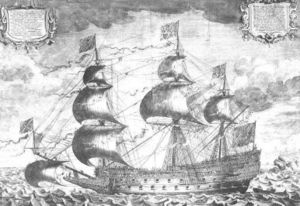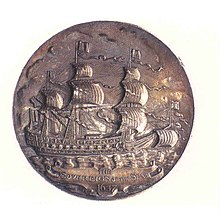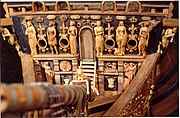HMSSovereign of the Seas
 'The true portrait of His Majesty's royal ship theSovereign of the Seas',a contemporaneous engraving by J. Payne
| |
| History | |
|---|---|
| Name | Sovereign of the Seas |
| Builder | Peter Pett,Woolwich Dockyard |
| Launched | 13 October 1637 |
| Renamed |
|
| Fate | Burnt, 1697 |
| Notes | |
| General characteristics as built[1] | |
| Class and type | 90-gunfirst-rateship of the line |
| Tons burthen | 1522 |
| Length | 127 ft (39 m) (keel) |
| Beam | 46 ft 6 in (14.17 m) |
| Depth of hold | 19 ft 4 in (5.89 m) |
| Propulsion | Sails |
| Sail plan | Full-rigged ship |
| Armament |
|
| General characteristics after 1660 rebuild[2] | |
| Class and type | 100-gunfirst-rateship of the line |
| Tons burthen | 1605 |
| Length | 127 ft (39 m) (keel) |
| Beam | 47 ft 6 in (14.48 m) |
| Depth of hold | 19 ft 2 in (5.84 m) |
| Propulsion | Sails |
| Sail plan | Full-rigged ship |
| Armament | 100 guns of various weights of shot |
| General characteristics after 1685 rebuild[3] | |
| Class and type | 100-gun first-rate ship of the line |
| Tons burthen | 1683 tons |
| Length | 167 ft 9 in (51.13 m) (gundeck) |
| Beam | 48 ft 4 in (14.73 m) |
| Depth of hold | 19 ft 4 in (5.89 m) |
| Propulsion | Sails |
| Sail plan | Full-rigged ship |
| Armament | 100 guns of various weights of shot |
Sovereign of the Seaswas a 17th-centurywarshipof theEnglish Navy.She was ordered as a 90-gunfirst-rateship of the line,[1][4]but at launch was armed with 102 bronze guns at the insistence of the king.[4]She was later renamedSovereignunder the republicanCommonwealth,and thenHMS Royal Sovereignat the Restoration of Charles II.
The elaborately gilded stern ordered byCharles I of Englandmeant enemy ships knew her as the "Golden Devil".[5]She was launched on 13 October 1637, and served from 1638 until 1697, when a fire burnt the ship to the waterline atChatham.
History
[edit]
Sovereign of the Seaswas ordered in August 1634 on the personal initiative ofCharles I of England,as a prestige project. The decision provoked much opposition from the Brethren ofTrinity House,who pointed out that "There is no port in the Kingdome that can harbour this ship. The wild sea must be her port, her anchors and cables her safety; if either fail, the ship must perish, the King lose his jewel, four or five hundred man must die, and perhaps some great and noble peer".[6]
These objections were overcome with the help of AdmiralSir John Pennington,and work commenced in May 1635. This was supervised byPeter Pett,later a Commissioner of the Navy, guided by his father Phineas, the royalshipwright,and was launched atWoolwich Dockyardon 13 October 1637. As the second three-deckedfirst-rate(the first three-decker being thePrince Royalof 1610), she was the predecessor ofNelson'sVictory,although theRevenge,built in 1577 byMathew Baker,was the inspiration for her, providing the innovation of a single deck devoted entirely to broadside guns.[citation needed]
The most extravagantly decorated warship in the Royal Navy, she was adorned from stern to bow with gilded carvings against a black background, designed byAnthony van Dyck,and made byJohn ChristmasandMathias Christmas.Construction costs of £65,586 was funded byShip Money,thegildingalone being £6,691, the price of an average warship. For comparison, the total tax generated in 1637 was £208,000.
Charles ordered 102 bronze cannon, to ensure it was the most powerfully armed ship in the world; these were made byJohn Browne.[4]Sovereign of the Seashad 118 gun ports and only 102 guns. The shape of the bow meant that the foremost gun ports on the lower gun deck were blocked by the anchor cable. Consequently, the fore chase – the guns facing forward – occupied the next ports. There were twodemi-cannondrakes– one port, one starboard – some 11.5 feet (3.5 m) long, weighing together five tons (5000 kg). They had a bore of 6.4 to 6.75 inches (16.3 to 17.1 centimetres) and fired a shot weighing 32 to 36 pounds (15 to 16 kilograms), using around ten pounds of gunpowder.
In the third ports from the bow, there were two 11-foot (3.4 m) demi-cannon drakes weighing, together, 4.3 tons (4300 kg). Behind them were twenty cannon drakes, nine feet long, and weighing in all 45.7 tons (45700 kg). In the third port from the stern were two more 11-foot (3.4 m) demi-cannon drakes weighing, together, 4.3 tons (4300 kg). The last two ports on either side were occupied by the stern chase – four 10.5-foot (3.2 m) demi-cannon drakes weighing a total of 11.4 tons (11400 kg).
The middle gun deck had heavy fortifiedculverins– that is, guns short for their bore – fore and aft. There were two 11.5-foot (3.5 m) pieces, weighing 4.8 tons (4800 kg), in the fore chase; four 11.5-foot (3.5 m) pieces, weighing 10.2 tons (10200 kg), in the stern chase. Immediately behind the fore chase were two demi-culverin drakes, eight to nine feet (2.4 to 2.7 m) long, weighing some 1.9 tons (1900 kg). Then came twenty-two 9.5-foot (2.9 m) culverin drakes weighing a total of 30.4 tons (30400 kg).
On the upper gun deck there were two 10-foot (3.0 m) fortified demi-culverins in the fore chase and two in the stern chase, both pairs weighing 2.8 tons (2800 kg). Between them there were twenty-two demi-culverin drakes, eight to nine feet (2.4 to 2.7 m) long, weighing over 21 tons (21000 kg) in total.
There were eight eight-to-nine-foot (2.4 to 2.7 m) demi-culverin drakes weighing 7.7 tons (7700 kg) in the forecastle; another six weighing 5.7 tons (5700 kg) on the half-deck. The quarterdeck carried two six-foot demi-culverin drake cutts – a cutt, again, being a shorter version of a gun – weighing 16 hundredweight (726 kg). Then there were another two six-foot culverin cutts, weighing 1.3 tons (1,179 kg), aft of the forecastle bulkhead. In all,Sovereign of the Seascarried 155.9 tons (141,430 kg) of guns – and that did not include the weight of the gun carriages. Altogether they cost £26,441 13s 6d including £3 per piece to have theTudor rose,a crown and the motto:Carolvs Edgari sceptrvm aqvarum– "Charles has established Edgar’s sceptre of the waters" – engraved on them. The gun carriages, made by Matthew Banks, Master Carpenter for the Office of Ordinance, cost another £558 11s 8d.
By 1642, her armament had been reduced to 90 guns.[1]Until 1655, she was also exceptionally large for an English vessel; no other ships of Charles were larger thanPrince Royal.

Sovereign of the Seaswas not so much built because of tactical considerations, but as a deliberate attempt to bolster the reputation of the English crown. Her name was, in itself, a political statement as Charles tried to revive the perceived ancient right of the English kings to be recognised as the 'lords of the seas.' English ships demanded that other ships strike their flags in salute, even in foreign ports. The Dutch legal thinkerHugo Grotiushad argued for amare liberum,a sea free to be used by all. Such a concept was mainly favourable to Dutch trade; in reaction,John SeldenandWilliam Monsonpublished the bookMare Clausum( "the Closed Sea" ) in 1635, with special permission of Charles, which attempted to prove thatKing Edgarhad already been recognised asRex Marium,or "sovereign of the seas" – this book had been previously repressed byJames I.The name of the ship explicitly referred to this dispute; King Edgar was the central theme of thetransomcarvings.[7]
Rear-Admiral SirWilliam Symondsnoted that after the ship's launch she was "cut down" and made a safe and fast ship. In the time of theCommonwealth of Englandall ships named after royalty were renamed; it was first decided to change the name of the ship intoCommonwealth,but in 1650 it became a simpleSovereign.[8]In 1651 she was again made more manoeuvrable by reducing upperworks after which she was described as "a delicate frigate (I think the whole world hath not her like)".[9]She served throughout the wars of the Commonwealth and became the flagship ofGeneral at SeaRobert Blake.She was involved in all of the great English naval conflicts fought against theUnited ProvincesandFranceand was referred to as 'The Golden Devil' (den Gulden Duvel) by the Dutch.

When, during theFirst Anglo-Dutch War,on 21 October 1652 theStates General of the Netherlandsin a secret session determined the reward money for the crews offireshipsthat succeeded in destroying an enemy vessel,Sovereignwas singled out: an extra prize of 3000 guilders was promised 'in case they should ruin the ship named the Sovereign'.[10]The ship had not seen action during the Civil War, remaining laid up. After being refitted in 1651, she had her first fight in theBattle of the Kentish Knock,armed with 106 guns.[11]In this battle she ran aground on theKentish Knockitself.[12]Although repeatedly occupied by the Dutch in the fiercest of engagementsSovereignwas retaken every time[citation needed]and remained in service for nearly sixty years as the best ship in the English fleet. By 1660 her armament had been changed to 100 guns.[1]After theEnglish Restorationshe was rebuilt at Chatham in 1660 as a first-rate ship of the line of 100 guns,[2]with flatter gundecks and renamedRoyal Sovereign;most of the carvings had been removed.
She was present at theFour Days' Battleof 1 to 4 June 1666, and theSt. James's Day Battleof 25 July 1666, each fighting the Dutch fleet in the North Sea.[5]
She was smaller thanNaseby(later renamedRoyal Charles), but she was in regular service during the threeAnglo-Dutch Wars,surviving theRaid on the Medwayin 1667 by being atPortsmouthat the time.[13]She underwent a second rebuild in 1685 atChatham Dockyard,relaunching as a first rate of 100 guns,[3]before taking part in the outset of theWar of the Grand Alliance.For the first time she ventured into theIrish Sea,[14]and later participated in theBattle of Beachy Head (1690)and theBattle of La Hougue(1692), when she was more than fifty years old. In that period she was the first ship in history that flewroyalsabove hertopgallant sailsand a topgallant sail on thejigger-mast.[15]
Destruction
[edit]Sovereignbecame leaky and defective with age during the reign ofWilliam III,and was laid up atChatham Dockyardsfor repairs late in 1695.
She ignominiously ended her days, in mid January 1696,[3][4]by being burnt to the water line as a result of having been set on fire by accident (it was 1697 in continental Europe, due tomore modern calendarthere). A bosun, who was on night watch, left a candle burning unattended. Admitting to his fault he wascourt-martialledon 27 January 1696[16]and not only publiclyfloggedbut also imprisoned atMarshalseafor the rest of his life.[17]
In her honour, naval tradition has kept the name of this ship afloat, and several subsequent ships have been namedHMSRoyal Sovereign.
In popular culture
[edit]A painting from this ship survives on the ceiling of Commissioners House atChatham Dockyard,over the grand staircase. It depicts an assembly of the gods and depicts Mars being crowned by Neptune, surrounded by the goddesses Hope, Peace, Justice and Plenty. The painting is surrounded by a gilded frieze depicting sea creatures. It is attributed toJames Thornhill,the King'sSerjeant Painter.He painted the ceilings of the Royal Hospital Greenwich and the Dome of Saint Paul's Cathedral.
Thomas Carew's poem "Upon the Royal Ship called the 'Sovereign of the Seas', built by Peter Pett, Master Builder; His Father, Captain Phineas Pett, Supervisor: 1637" is a paean to the vessel, calling it the eighth wonder of the world:[18]
... Monarchal Ship, whose Fabrick doth outpride
ThePharos,Colosse,Memphique Pyramide...
We ythave heard of Seaven, now see yeEight
Wonder at home; of Naual art the height...
Neptuneis proud o'th burden, and doth wonder
To hear a Fourefold Fire out-roreIouv's Thunder...
-
Model ofSovereign of the Season display in the Bodrum Museum of Underwater Archaeology, Bodrum, Turkey, withroyals
-
Stern ofSovereign of the Seas
-
Carvings onSovereign of the Seas'beakhead bulkhead
See also
[edit]References
[edit]- ^abcdLavery,Ships of the Linevol. 1, p. 158.
- ^abLavery,Ships of the Linevol. 1, p. 160.
- ^abcLavery,Ships of the Linevol. 1, p. 163.
- ^abcdRoyal Navy,Sovereign of the Seas.
- ^abFamous Fighters of the Fleet, Edward Fraser, 1904, p.200
- ^Berckman 1974,p. 79.
- ^Simon Schama,1988,The Embarrassment of Riches,New York, p. 230
- ^Evelyn Berckman,Creators and Destroyers of the English Navy — as related by the State Papers Domestic,London 1974, p.81
- ^Rodger, N.A.M. (2004),The Command of the Ocean: A Naval History of Britain 1649–1815,Penguin Group, p. 216
- ^Age Scheffer,Roemruchte jaren van onze vloot,Baarn 1966, p.21:ingeval sijluyden het schip genaemt de Souverain komen te ruineren
- ^Angus Konstam,Warships of the Anglo-Dutch Wars 1652–74.Osprey Publishing 2011, p.28
- ^Rodger, N.A.M. (2004),The Command of the Ocean: A Naval History of Britain 1649–1815,Penguin Group, p. 14
- ^Rodger, N.A.M. (2004),The Command of the Ocean: A Naval History of Britain 1649–1815,Penguin Group, p. 77
- ^Rodger, N.A.M. (2004),The Command of the Ocean: A Naval History of Britain 1649–1815,Penguin Group, p. 144
- ^Age Scheffer,Roemruchte jaren van onze vloot,Baarn 1966, p. 193
- ^Public Records Office: Secretary's Department of the Admiralty In-Letters 5256
- ^Famous Fighters of the Fleet, Edward Fraser, 1904, p.201
- ^Dunlop, Rhodes (April 1941). "Thomas Carew, Thomas Carey, and The Sovereign of the Seas".Modern Language Notes.56(4). Johns Hopkins University Press: 268–271.doi:10.2307/2910435.JSTOR2910435.
Sources
[edit]- Sovereign of the Seas.Retrieved 22 December 2007.
- Berckman, Evelyn (1974).Creators and Destroyers of the English Navy.Hamish Hamilton.ISBN978-0241890349.
- Lavery, Brian (2003)The Ship of the Line – Volume 1: The development of the battlefleet 1650–1850.Conway Maritime Press.ISBN0-85177-252-8.




